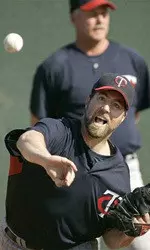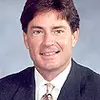University of Tennessee Athletics

Former Vol Dickey Reinvents Himself With Knuckleball
March 08, 2009 | Baseball
March 8, 2009
By DAVID DORSEY, news-press.com
Minnesota Twins pitcher R.A. Dickey joined a small professional baseball fraternity in 2005 in order to resurrect his career.
Dickey, who was born without the Tommy John ligament in his right elbow, switched to throwing almost exclusively the knuckleball.
"I had to leave who I used to be behind," said Dickey, whose parents began calling him R.A., short for Robert Allen, shortly after he was born in Nashville, Tenn.
"I had tried to hang on to that," said Dickey, 34, who threw the fastball, curveball and changeup as an All-American at the University of Tennessee.
The Texas Rangers selected Dickey in the first round of the 1996 draft, largely because of his 94-mile-per hour fastball. Like Dickey himself, the organization did not realize the medical marvel inside Dickey's arm.
Enduring elbow surgery to remove bone spurs in 1997, Dickey realized the fragility of his arm. He began fluctuating between starting and relieving. He became stuck in the minor leagues.
Not until 2003 did he first try throwing the knuckleball at the suggestion of former Dodgers pitcher Orel Hershiser.
"If anyone was going to reinvent himself, it was going to be him," said former Tennessee coach Rod Delmonico, who caught up with Dickey on Thursday. Delmonico is managing the Netherlands national team in the World Baseball Classic.
"He just knows how to win," Delmonico said, noting Dickey's school record of 38 wins.
Entering this season, Dickey has a 73-68 record and 4.33 ERA in the minors. He has gone 21-27 with a 5.57 ERA in the majors. Last season, he went 5-8 with a 5.21 ERA, making 14 starts and 18 relief appearances for the Seattle Mariners.
"A guy like him can start. He can come out of the bullpen. He can pitch every day," said Twins pitching coach Rick Anderson, who had not coached a knuckleball pitcher prior to Dickey. "It's new for me. The more you watch him, the more you see things and figure him out. It's a different look. It's tough to hit."
Dickey said he finally feels he has control -- if you can call it that -- of throwing the knuckleball, which can confound hitters and catchers alike.
"It really has prolonged my career," Dickey said. "I'm not going to be that other guy anymore. When I pitched for the big leagues again, that's what I had to do. My velocity topped out at 66, 67 when it was topping out at 93, 94 before. I'm holding the hope that I can have a really good year.
"I'm just learning more about myself. I'm more comfortable with it."
Redmond caught Dickey on this afternoon at Hammond Stadium. Dickey did not allow any hits, getting two groundouts, a flyout and hitting a batter in the fifth inning against the Pittsburgh Pirates.
Pittsburgh won 10-1.
"It's a challenge," said Twins catcher Mike Redmond, who caught knuckleballer Russ Springer while with the Florida Marlins. "It's uncomfortable for a catcher. You can do everything right and miss the ball, which is not fun. It makes it a little more challenging because of all the movement. You're so geared up for hitting fastballs. Then you get something like a knuckleball that looks totally different."
Dickey spent part of the offseason in Atlanta working with Hall of Fame knuckleball thrower Phil Niekro. Dickey also consults with Tim Wakefield of the Boston Red Sox. Wakefield, 42, has pitched for 16 big-league seasons using the knuckleball.
"I've got him on speed-dial," said Dickey, who has spent the past four years honing his craft.
"I couldn't have my feet in both spots," said Dickey, who only occasionally throws a fastball. "I had to have the courage to do something that was very risky. "I really committed to it and realized, this is who I was. And I was never going to be that other guy again. It was sad to think about that, but at the same time, it gave me a lot of hope."

















